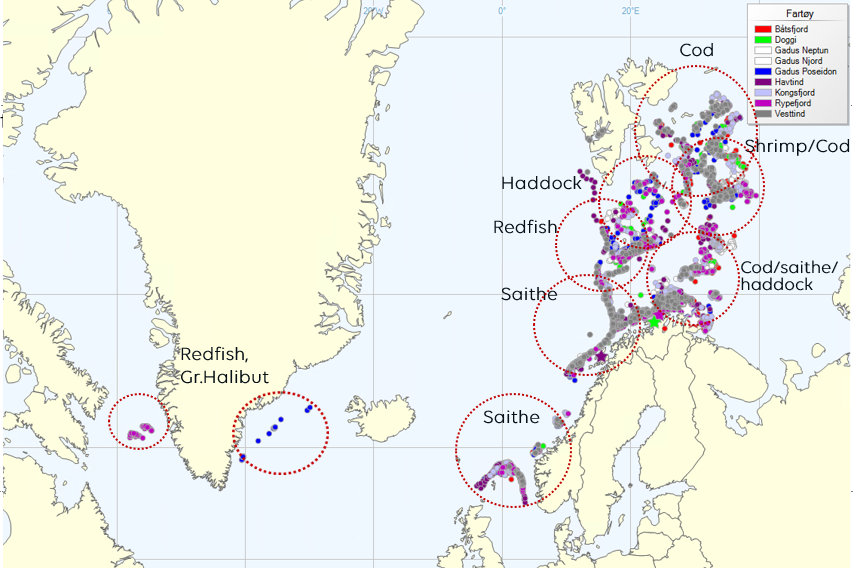-
SEARCH
Type your search in the field above

Sustainable management is central to the Norwegian fishing industry, and includes biological, social and economic sustainability. Biological sustainability means that marine resources, such as fish stocks, must be utilized in a way that allows them to continue fishing into the future. This is managed by means of quotas to avoid overfishing, and these are based on stock surveys that are done every year. Social sustainability is about the distribution of resources between different actors, such as the coastal and ocean-going fleets, or between different regions along the coast. Economic sustainability means that fishing is economically profitable, so that fishermen earn enough to live, and that the nation of Norway earns from exporting seafood.
Advice and recommendations from ICES form the main basis for setting fishing quotas. Researchers from the member countries prepare the various councils in groups and advisory committees. After ICES has come up with its quota recommendations, it starts negotiations between Norway and other states. When the international negotiations are completed, the national regulatory start the process.
Norway is a member of five regional fisheries management organizations (RFMOs). These are the Northeast Atlantic Fisheries Commission (NEAFC) and the Northwest Atlantic the Fisheries Organization (NAFO). Norway is also a member of the Southeast Atlantic Fisheries Organization (SEAFO), the International Commission for the Conservation of Atlantic Tuna (ICCAT) and the Convention of the Conservation of Antarctic Living Marine Resources (CCAMLR).
We depend on sustainable management of marine natural resources and maintenance of clean and productive marine areas. In our main operating area, more than 90% of all Norwegian wild fish landed annually are certified as sustainable according to MSC-certified sustainable fisheries. Main catch species for Lerøy Havfisk is cod, haddock, saith and shrimp caught in the North Sea, Norwegian Sea, and Barents Sea (FAO27)

Research and advice from the Institute of Marine Research in Bergen and the International Council for the Exploration of the Sea (ICES) shall help ensure that future generations are able to harvest the major assets in the sea and along the coast.
One of the vessels owned by our subsidiary Lerøy Havfisk is part of the Institute of Marine Research's reference fleet. As such, we play a part in collecting a significant amount of biological data utilized in the research into fish stocks. Norway enters negotiations with other countries when total fishing quotas are to be established. The final decisions regarding the total quotas for fishing different species are made based on stock assessments and advice on quotas from ICES.
More than 90% of the fish resources harvested by Norway are managed in cooperation with other countries. The national quotas in Norway are discussed by the various stakeholders during regulation meetings, for which the Norwegian Directorate of Fisheries is responsible. These regulation meetings are held twice a year.
Subsequent to the discussions at these meetings, the Directorate of Fisheries issues a proposal for regulation of fisheries to the Norwegian Ministry of Trade, Industry and Fisheries. The Ministry issues provisions regarding the distribution of quotas to Norwegian fishing vessels and provisions regarding fisheries in the form of annual regulations for each species of fish.
Our operations are based on public permits for the harvesting of Norwegian fish resources. The entitlement provided by these permits entails statutory obligations in terms of activity and delivery, as well as a responsibility to fish sustainably. It is our aim to be a “proud custodian”, and we have taken an active approach to ensuring full compliance with all regulations involving fisheries.
We manage our natural resources on behalf of society, and therefore accept a particular responsibility for ensuring sustainable operations, leaving behind the smallest possible environmental footprint. The Group monitors all employees and management to ensure compliance with prevailing regulations and quota provisions. The Group has also cooperated with authorities, trade associations and nongovernmental organizations to help counteract illegal fishing, thereby safeguarding resources for future generations.
In 2016, Lerøy Havfisk and the other parties involved in the Norwegian trawling industry entered the Arktisavtalen (Industry Group Agreement on cod fisheries in the northern part of the North-East Atlantic). As a result of the melting ice sheet around the North Pole and so-called new areas becoming accessible, a map has been prepared showing those regions traditionally fished.
The parties to the agreement committed to not fish in waters north of these areas until the seabed was charted and it had been established that fishing would not cause permanent damage to vulnerable benthic biotopes. In 2019 this agreement was replaced with new Norwegian government regulations to the same effect.
The regulations were implemented following open dialog between Government, industry, and NGOs. In addition to the vast areas protected under the new regulations, there are 19 areas along coastal Norway that are protected against bottom trawling to protect coral and other benthic organisms. Additionally, trawlers are not allowed to fish inside of 12 nautical miles along the entire Norwegian coast, with the exception of small trawlers that have a 6-mile limit. Around all of the Svalbard islands there is a 12-mile limit.
Areas protected in the Norwegian economic zone Source: The Norwegian Fishery Directory

Combined with a more comprehensive nature reserve where fishing is prohibited and a general prohibition on fishing in waters that are shallower than 100 meters around Svalbard, the protected area covers 70.000 square kilometers, not including all before mentioned new protected areas.
The minimum water depth of 100 meters protects food sources for animals that live on shore and birds that dive for food close to the coast. A number of other regulatory measures also apply, including a prohibition on fishing deeper than 1.000 meters to protect potentially vulnerable benthic biotopes in these areas.
